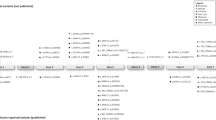Abstract
This study describes the phenotype/genotype analysis of 159 probands with neuronal ceroid lipofuscinosis (37 CLN1, 72 classic CLN2, 10 variant LINCL, and 40 CLN3) collected at the New York State Institute for Basic Research in Developmental Disabilities (IBR). Phenotype/genotype comparison showed that mutations in the CLN1 gene were associated with different phenotypes: infantile, late infantile, and juvenile. Two common mutations (223A → C and 451C → T) were found in 26 of 37 CLN1 subjects (64% of alleles examined). A nonsense point mutation, 451C → T, was the most common in CLN1 subjects with infantile onset at 0–2 years, accounting for 50% of alleles studied. A missense point mutation, 223A → C, was the most common among CLN1 subjects with juvenile onset older than 4 years, accounting for 45% of alleles examined. Twenty-one other CLN1 mutations were identified in 4 of 37 subjects with infantile onset, 6 of 37 with late-infantile onset, and 6 of 37 with juvenile onset. All CLN1 probands were palmitoyl-protein thioesterase (PPT)-deficient and showed granular osmiophilic deposits (GROD) at the electron microscopic (EM) level. In the group of classic CLN2 (72 probands), two common mutations were found; an intronic 3556G → C transversion in the invariant AG of 3’ splice junction in 55% of probands, and a nonsense mutation 3670C → T in 30% of probands. Classic late-infantile onset (2–4 years) was found in 68 of 72 (95%) cases. All probands had deficiency of tripeptidyl-peptidase I (TPP1) activity and, at the EM level, curvilinear profiles. Ten probands with late-infantil onset did not show mutations in the CLN2 gene, had normal TPP1 activity, and at the EM level had mixed profiles. Further studies are in progress to identify genetic defect(s) in these subjects. The CLN3 group (40 probands) was divided into two categories: classic or typical presentation, and delayed classic or atypical presentation. All CLN3 patients had onset of symptoms after 4 years of age. In 40 probands, the 1.02-kb common deletion was found in one or two alleles of the CLN3 gene. Homozygotes for the common CLN3 deletion showed the classic phenotype. The phenotype in compound heterozygotes was either the classic or the delayed classic or atypical form. Thus, our study indicates that some mutations in the CLN1 and CLN2 genes may be associated with juvenile onset of the disease process and a more benign clinical course. Interfamilial and intrafamilial variations also were found, especially in the speed of becoming blind and neurologically disabled.
Similar content being viewed by others
Author information
Authors and Affiliations
Rights and permissions
About this article
Cite this article
Wisniewski, K., Kida, E., Connell, F. et al. Neuronal ceroid lipofuscinoses: research update. Neurol Sci 21 (Suppl 1), S49–S56 (2000). https://doi.org/10.1007/s100720070040
Issue Date:
DOI: https://doi.org/10.1007/s100720070040




